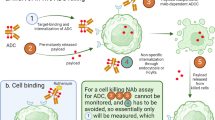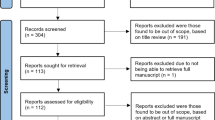Abstract
Today, the assessment of immunogenicity is integral in nonclinical and clinical testing of new biotherapeutics and biosimilars. A key component in the risk-based evaluation of immunogenicity involves the detection and characterization of anti-drug antibodies (ADA). Over the past couple of decades, much progress has been made in standardizing the generalized approach for ADA testing with a three-tiered testing paradigm involving screening, confirmation, and quasi-quantitative titer assessment representing the typical harmonized scheme. Depending on a biotherapeutic’s structural attributes, more characterization and testing may be appropriate. Unlike bioanalytical assays used to support the evaluation of pharmacokinetics or toxicokinetics, an important component in immunogenicity testing is the calculation of cut points for the identification (screening), confirmation (specificity), and titer assessment responses in animals and humans. Several key publications have laid an excellent foundation for statistical design and data analysis to determine immunogenicity cut points. Yet, the process for statistical determination of cut points remains a topic of active discussion by investigators who conduct immunogenicity assessments to support biotherapeutic drug development. In recent years, we have refined our statistical approach to address the challenges that have arisen due to the evolution in biotherapeutics and the analytical technologies used for quasi-quantitative detection. Based on this collective experience, we offer a simplified statistical analysis process and flow-scheme for cut point evaluations that should work in a large majority of projects to provide reliable estimates for the screening, confirmatory, and titering cut points.








Similar content being viewed by others
References
Shankar G, Devanarayan V, Amaravadi L, Barrett YC, Bowsher RR, et al. Recommendations for the validation of immunoassays used for detection of host antibodies against biotechnology products. J Pharm Biomed Anal. 2008;48:1267–81.
Shen M, Dong X, Tsong Y. Statistical evaluation of several methods for cut point determination of immunogenicity screening assay. J Biopharm Stat. 2016;25(2):269–79.
Su C, Zhou L, Hu Z, Weng W, Subramani J, Tadkod V, et al. Enhancing efficiency and quality of statistical estimation of immunogenicity assay cut points through standardization and automation. J Immunol Methods. 2015;425:88–96.
Schaarschmidt F, Hofmann M, Jaki T, Grun B, Hothorn LA. Statistical approaches for the determination of cut points in anti-drug antibody bioassays. J Immunol Methods. 2015;418:84–100.
Zhang J, Yu B, Zhang L, Roskos L, Richman L, Yang H. Non-normal random effects models for immunogenicity assay cut point determination. J Biopharm Stat. 2015;25(2):295–306.
Zhang J, Zhang L, Yang H. Sample size consideration for immunoassay screening cut point determination. J Biopharm Stat. 2014;24(3):535–45.
Ro D, Zhou L, Moxness M, Mytych D, Chirmule N, Jawa V. Statistical and bioanalytical consideration for establishing a depletion criterion for specificity testing during immunogenicity assessment of a biotherapeutic. AAPS J. 2013;15(4):1160–7.
Zhang L, Zhang JJ, Kubiak RJ, Yang H. Statistical methods and tool for cut point analysis in immunogenicity assays. J Immunol Method. 2013;389(1–2):79–87.
Kubiak RJ, Zhang L, Zhang J, Zhu Y, Lee N, Weichold FF, et al. Correlation of screening and confirmatory results in tiered immunogenicity testing by solution-phase bridging assays. J Pharm Biomed Anal. 2013;74:235–45.
Hoffman D, Berger M. Statistical consideration for calculation of immunogenicity screening assay cut points. J Immunol Methods. 2011;373(1–2):200–8.
Smith HW, Moxness M, Marsden R. Summary of confirmation cut point discussions. AAPS J. 2011;13(2):227–9.
Gunn GR, Sealey DC, Jamali F, Meibohm B, Ghosh S, Shankar G. From the bench to clinical practice: understanding the challenges and uncertainties in immunogenicity testing for biopharmaceuticals. Clin Exp Immunol. 2016;184(2):137–46.
Pineda C, Hernandex GC, Jacobs IA, Alvarez DF, Carini C. Assessing the immunogenicity of biopharmaceuticals. BioDrugs. 2016;30(3):195–206.
Bandyopahyay A. Complexities of protein therapeutics and immunogenicity. J Bioanal Biomed. 2015;7(3):70–4.
Swanson SJ, Bussiere J. Immunogenicity assessment in non-clinical studies. Curr Opin Microbiol. 2012;15:337–47.
US Food and Drug Administration. Guidance for industry: assay development and validation for immunogenicity testing of therapeutic protein products. 2016.
US Food and Drug Administration. Guidance for industry: immunogenicity assessment for therapeutic protein products. 2013.
Collet-Brose J, Couble P-J, Deehan MR, Nelson RJ, Ferlin WG, Lory S. Evaluation of multiple immunoassay technology platforms to select the anti-drug antibody assay exhibiting the most appropriate drug and target tolerance. J Immunol Res. 2016:article ID 5069678. doi:10.1155/2016/5069678.
Wadhwa M, Knezevic I, Kang H-N, Thorpe R. Immunogenicity assessment of biotherapeutic products: an overview of assays and their utility. Biologicals. 2015;43:298–306.
Finco D, Baltrukonis D, Clements-Egan A, Delaria K, Gr G, Lowe J, et al. Comparison of competitive ligand-binding assay and bioassay formats for the measurement of neutralizing antibodies to protein therapeutics. J Pharm Biomed Anal. 2011;54(2):351–8.
Wadhwa M, Gaines-Das R, Thorpe R, Mire-Sluis A. Detection, measurement, and characterization of unwanted antibodies induced by therapeutic biologicals. Dev Biol (Basel). 2005;122:155–70.
Mire-Sluis AR, Barrett YC, Devanarayan V, Koren E, Liu H, Maia M, et al. Recommendations for the design and optimization of immunoassays used in the detection of host antibodies against biotechnology products. J Immunol Methods. 2004;289(1–2):1–16.
Mire-Sluis AR. Challenges with current technology for the detection, measurement and characterization of antibodies against biological therapeutics. Dev Biol (Basel). 2002;109:59–69.
Jacobs I, Petersel D, Shane LG, Ng CK, Krichhoff C, Finch G, et al. Monoclonal antibody and fusion protein biosimilar across therapeutic areas: a systematic review of published evidence. BioDrugs. 2016;30(3):195–206. doi:10.1007/s40259-016-0174-5. Review
Wang W, Wang EQ, Balthasar JP. Monoclonal antibody pharmacokinetics and pharmacodynamics. Clin Pharmacol Ther. 2008;84(5):548–58.
Chen YQ, Pottanat TG, Carter QL, Troutt JS, Konrad RJ, Sloan JH. Affinity capture elution bridging assay: a novel immunoassay format for detection of anti-therapeutic protein antibodies. J Immunol Method. 2016;431:45–51.
Zoghbi J, Xy Y, Grabert R, Theobald V, Richards S. A breakthrough novel method to resolve the drug and target interference problem in immunogenicity assays. J Immunol Method. 2015;426:62–9.
Dai S, Schantz A, Clements-Egan A, Cannon M, Shankar G. Development of a method that eliminates false-positive results due to nerve growth factor interference in the assessment of fulranumab immunogenicity. AAPS J. 2014;16(3):464–77.
Tatarewicz S, Miller JM, Swanson SJ, Moxness MS. Rheumatoid factor interference in immunogenicity assays for human monoclonal antibody therapeutics. J Immunol Methods. 2010;357(1–2):10–6.
Tukey J. Exploratory data analysis, Addison-Wesley, 1977; 43–44.
Bulmer MG. Principles of statistics (Dover). 1979.
Shapiro SS, Wilk MB. Analysis of variance test for normality (complete samples). Biometrika. 1965;52:591–611.
Amaravadi L, Song A, Myler H, Thway T, Kirshner S, Devanarayan V, et al. White paper on recent issues in bioanalysis: focus on new technologies and biomarkers (part 3 - LBA, biomarkers and immunogenicity). Bioanalysis. 2015;7(24):3107–24.
U.S. Pharmacopeia and the National Formulary (USP-NF). General Chapter <1106> Immunogenicity assays—design and validation of immunoassays to detect anti-drug antibodies. 2014.
U.S. Pharmacopeia and the National Formulary (USP-NF). General Chapter <1106> Immunogenicity assays <1106.1>—design and validation of assays to detect neutralizing antibody anti-drug [NEW] (USP38-NF33 1S). 2015.
European Medicines Agency. Guideline on immunogenicity assessment of biotechnology-derived therapeutic proteins (draft). 2015.
Mosteller F, Tukey JW. Robust and resistant measures of location and scale. In: Data analysis and regression: a second course in statistics, Chapter 10, Addison-Wesley Publishing Company. 1977.
Levene H. Robust tests for the equality of variances. In: Olkin I, editor. Contributions to probability and statistics. New York: Stanford University Press; 1960.
Wikipedia. Grubbs’ test for outliers. Last edited 2016.
Gupta S, Devanarayan V, Finco D, Gunn G, Kirshner S, Richards S, et al. Recommendations for the validation of cell-based assays used for the detection of neutralizing antibody immune responses elicited against biological therapeutics. J Pharm Biomed Anal. 2011;55:878–88.
Author information
Authors and Affiliations
Corresponding author
Rights and permissions
About this article
Cite this article
Devanarayan, V., Smith, W.C., Brunelle, R.L. et al. Recommendations for Systematic Statistical Computation of Immunogenicity Cut Points. AAPS J 19, 1487–1498 (2017). https://doi.org/10.1208/s12248-017-0107-3
Received:
Accepted:
Published:
Issue Date:
DOI: https://doi.org/10.1208/s12248-017-0107-3




